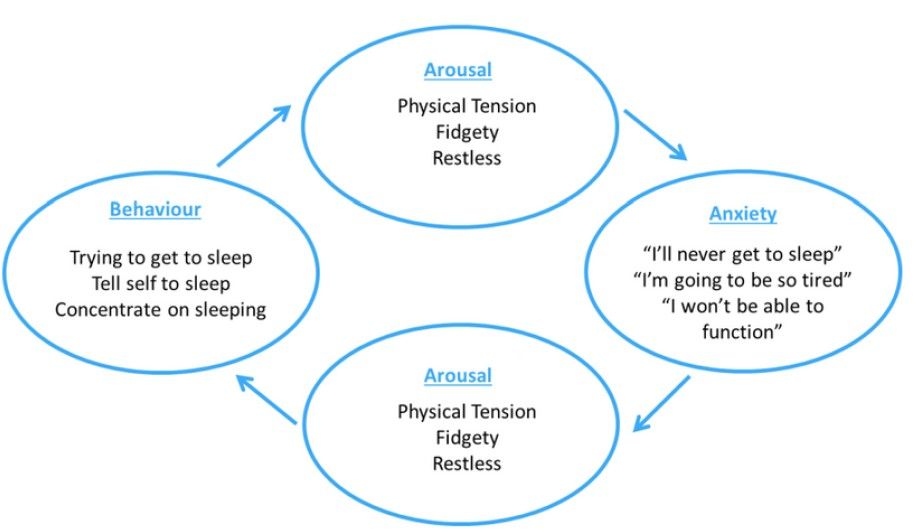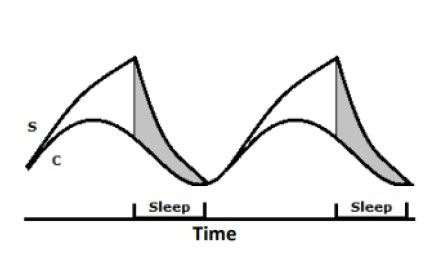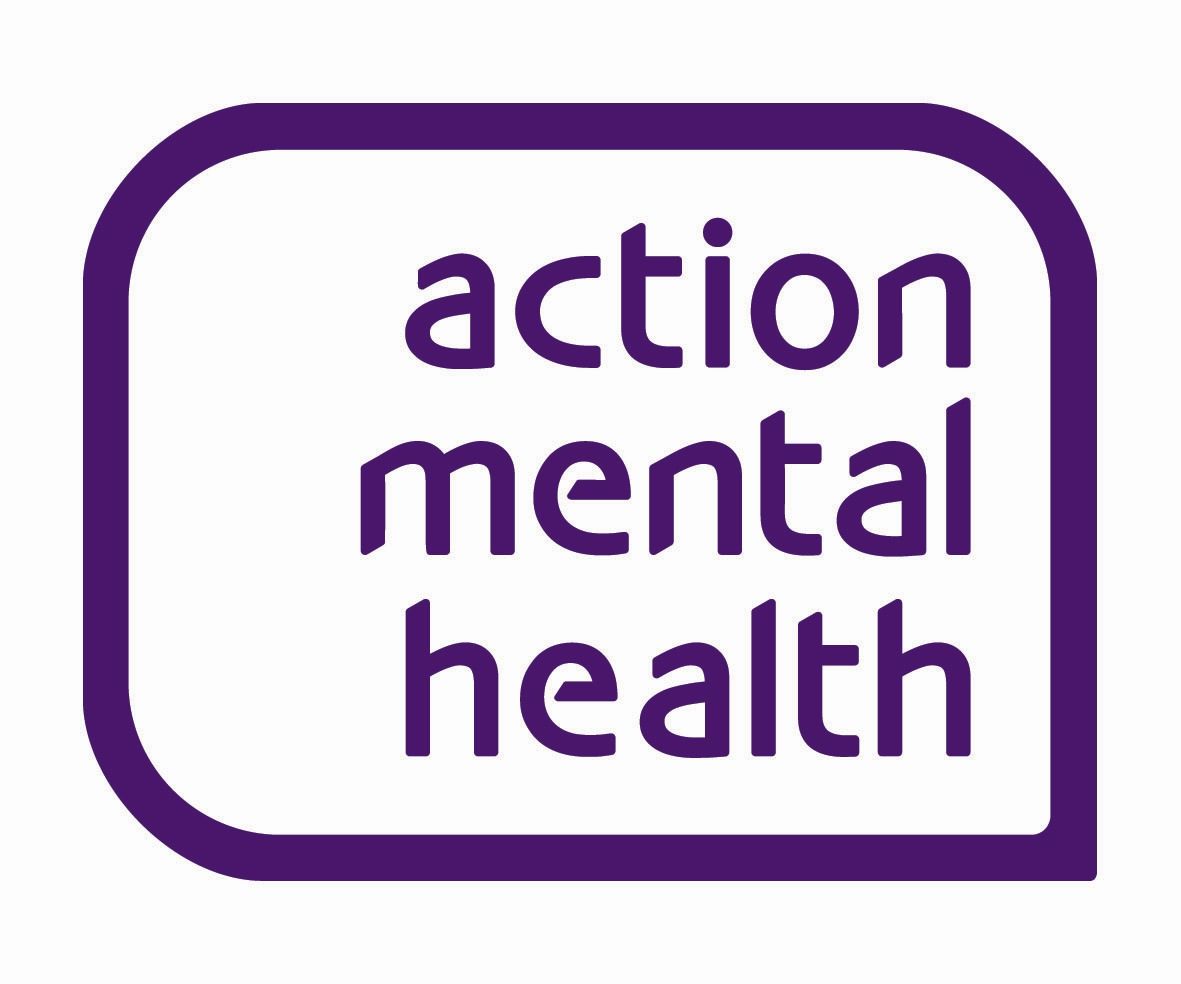Toolkit: Improving Sleep
Sleep is crucial for our overall well-being, contributing to both our
physical and emotional health. While it's common to encounter
sleep issues at some point, persistent sleep problems can
sometimes lead to feelings of sadness or anxiety. These
disruptions can significantly affect our daily lives. Sleep plays a
vital role in restoring both our body and mind, impacting memory,
focus, performance, mood, and overall health. Given its
importance, any disruption in sleep can make it challenging to
function effectively on a day-to-day basis.

What is sleep?
Sleep is a period of restful unresponsiveness that follows a predictableand active process, regulated by two separate systems in our body: homeostasis and the circadian rhythm.
The best quality sleep occurs when these two systems are in sync. The graph below shows how homeostasis and the circadian rhythminteract to create our 24-hour wake-sleep cycle. The shaded area represents sleep time, during which our need for sleep gradually diminishes. However, external factors or situations can sometimes disrupt this process, keeping us awake when we should be sleeping.
- Homeostasis drives our need for sleep. The longer we stay awake,the sleepier we feel, as being awake increases our need for rest.Once we fall asleep, our need for sleep gradually decreases.
- Circadian rhythm is our internal biological clock, operating on aroughly 24-hour cycle. This rhythm also controls other bodily functions, such as temperature, blood pressure, and hormone levels.
The best quality sleep occurs when these two systems are in sync. The graph below shows how homeostasis and the circadian rhythminteract to create our 24-hour wake-sleep cycle. The shaded area represents sleep time, during which our need for sleep gradually diminishes. However, external factors or situations can sometimes disrupt this process, keeping us awake when we should be sleeping.

Improving Sleep
The 5 Stages of Sleep
Sleep consists of five stages that occur in cycles throughout the night.Each cycle lasts about 90 minutes, and we experience 4-5 cycles during atypical night of sleep:
- Stage One: This is the transition from being awake to falling asleep.During this stage, our muscles begin to relax, and we can easily be awakened.
- Stage Two: In this stage, we enter light sleep, where our breathing and heart rate slow down. We can still be easily woken during this phase. Adults spend 50-60% of each sleep cycle in this stage.
- Stage Three: This is a deep sleep stage where our breathing and heartrate reach their lowest levels.
- Stage Four: This is another deep sleep phase, with rhythmic breathing and heart rate, and minimal muscle activity.
- Stage Five (REM): Known as Rapid Eye Movement (REM) sleep, this stage is when most dreams occur. Our blood pressure and heart raterise, and our eyes move rapidly, while our bodies remain still.
After REM sleep, we return to stage one and continue cycling through the stages 4-5 times throughout the night.
Sleep Hygiene
Sleep hygiene refers to a set of practices designed to improve the quality of sleep. If you've been struggling with sleep issues for a while, you may have already looked for tips online or asked for advice. While you might have tried some of these suggestions, it's important to implement all of them consistently and for a prolonged period to see the best results.
- Limit caffeine (found in tea, coffee, and chocolate) for at least four hours before bedtime. Caffeine is a stimulant that can interfere withsleep.
- Avoid nicotine, including patches, vaporizers, and gum, at least onehour before bedtime.
- Nicotine is another stimulant that can prevent you from fallng asleep.
- Steer clear of alcohol close to bedtime. While it may seem like alcohol helps you fall asleep, it can disrupt sleep quality and affect the deeperstages of rest.
- Don't eat large meals before bed, and avoid going to bed either too hungry or too full, as it can affect your sleep.
- Exercise regularly, but avoid working out for at least two hours before bedtime, as it can make it harder to fall asleep.
- Create a calm and tidy bedroom . Choose comfortable bedding, and try to make your bed each morning to set a positive tone for the day.
- Maintain a comfortable room temperature, avoiding extremes of hotor cold.
- Keep your bedroom quiet and dark at night, and try to get somesunlight exposure during the day to regulate your body’s sleep-wakecycle.
- Reserve the bedroom for sleep. Avoid activities like reading, eating,using electronics, or watching TV in bed. Stick to regular bedtimes and wake-up times every day to help regulate your body's internal clock.
Keep a sleep diary
To evaluate whether the above tips help you, keep a sleep diary by recording the following information each day:
- The time you went to bed and the time you woke up in the morning.
- The time you first fell asleep and the time you woke up during the night.
- The total amount of time you were awake during the night (in minutes).

Setting your sleep window
Sleep restriction begins by calculating the "sleep window" based on the data collected from the sleep diary. The sleep window establishes the fixed times for going to bed and waking up, which corresponds to the average number of hours slept each night over the past two weeks.The rules of sleep restriction are as follows:
- Do not go to bed before the start of the sleep window, even if you feel tired.
- If you're still awake when the sleep window begins, wait until you feel sleepy before going to bed.
- The end of the sleep window, which marks the time to get up, is fixed. You should get out of bed at the end of the sleep window, even if you're still tired or sleepy.
In the beginning, it's normal to feel more tired or sleepy during the day, but this is temporary. Even though your time in bed may be shorter, you might function better during the day, and your sleep quality will likely improve.This improvement is what we're aiming for and will be reflected in the sleep diary as "sleep efficiency." Sleep efficiency refers to the percentageof time spent asleep while in bed. A desirable sleep efficiency is between 80-85%, which is considered average. Sleep efficiency helps guideadjustments to the sleep window. If sleep efficiency drops below 80%,reduce the sleep window by 15 minutes. It's important not to shorten the sleep window to less than 5 hours to avoid excessive sleep deprivation. If sleep efficiency goes above 80%, you can add an extra 15 minutes to thesleep window.
Continue with sleep restriction. If sleep efficiency decreases, stick to the previous sleep window. This will often be the optimal balance of sleep quality and quantity.
Continue with sleep restriction. If sleep efficiency decreases, stick to the previous sleep window. This will often be the optimal balance of sleep quality and quantity.
Stimulus Control
Our beds and bedrooms play a key role in signaling sleep, helping us feel
sleepy. However, if we struggle with sleep, we often spend a lot of time
awake in bed, which weakens these sleep signals. The goal of stimulus
control is to minimize the time spent awake in bed, thereby strengthening
the connection between our bed and sleep.
To associate our bed with sleep, we should only use it for sleeping or for lying down when we're ready to sleep. This helps reinforce the link between the bed and the physiological changes that prepare us for sleep. When sleep disruptions occur over time, we can form negative associations between sleep and the bed, as we spend too much time awake while in bed.These negative associations can make us feel more alert when we get into bed, making it harder to fall asleep.
To improve this, there are seven key rules of stimulus control that should be followed:
To associate our bed with sleep, we should only use it for sleeping or for lying down when we're ready to sleep. This helps reinforce the link between the bed and the physiological changes that prepare us for sleep. When sleep disruptions occur over time, we can form negative associations between sleep and the bed, as we spend too much time awake while in bed.These negative associations can make us feel more alert when we get into bed, making it harder to fall asleep.
To improve this, there are seven key rules of stimulus control that should be followed:
- Do not go to bed before the scheduled time. It's important to spend the last hour before bed doing something relaxing outside of your bedroom to help you unwind.
- Go to bed only when you're tired, with the intention to sleep. Only enter your bed during the sleep window when you're feeling tired. If you feel tired before the scheduled time, try to delay going to bed until the agreed time.
- If you can't fall asleep within 20 minutes, get up and do something relaxing in another room. Lying awake in bed won't help you feel more rested—it can actually increase your arousal and make it harder to sleep. If you're still awake after about 20 minutes, get up, leave your bedroom, and engage in a quiet, relaxing activity. Only return to bed when you feel sleepy again.
- If you return to bed and don't fall asleep within 20 minutes, repeat rule 3. If you've gone back to bed and still can’t fall asleep, after about 20 minutes, get up again and only return to bed once you feel truly sleepy.
- Reserve your bed and bedroom for sleep and intimacy only. It's common to check phones, watch TV, or read while lying in bed, but these activities can worsen sleep problems. They create a negative association between your bed and wakefulness, making it harder to sleep.
- Use an alarm clock to set a consistent wake-up time. Try to wake up at the same time every day, including weekends, regardless of how much sleep you’ve had or how tired you feel. This helps regulate your internal body clock. Avoid sleeping in, as this can disrupt your sleep-wake cycle.
- Avoid daytime naps. Napping during the day can reduce both the quality and quantity of yournighttime sleep.

Action Mental Health is a charity which has been at the forefront of mental health support since 1963. supporting recovery and changing lives. We believe that when employees are supported, we'll see a healthier more engaged workforce.
Copyright © 2025
